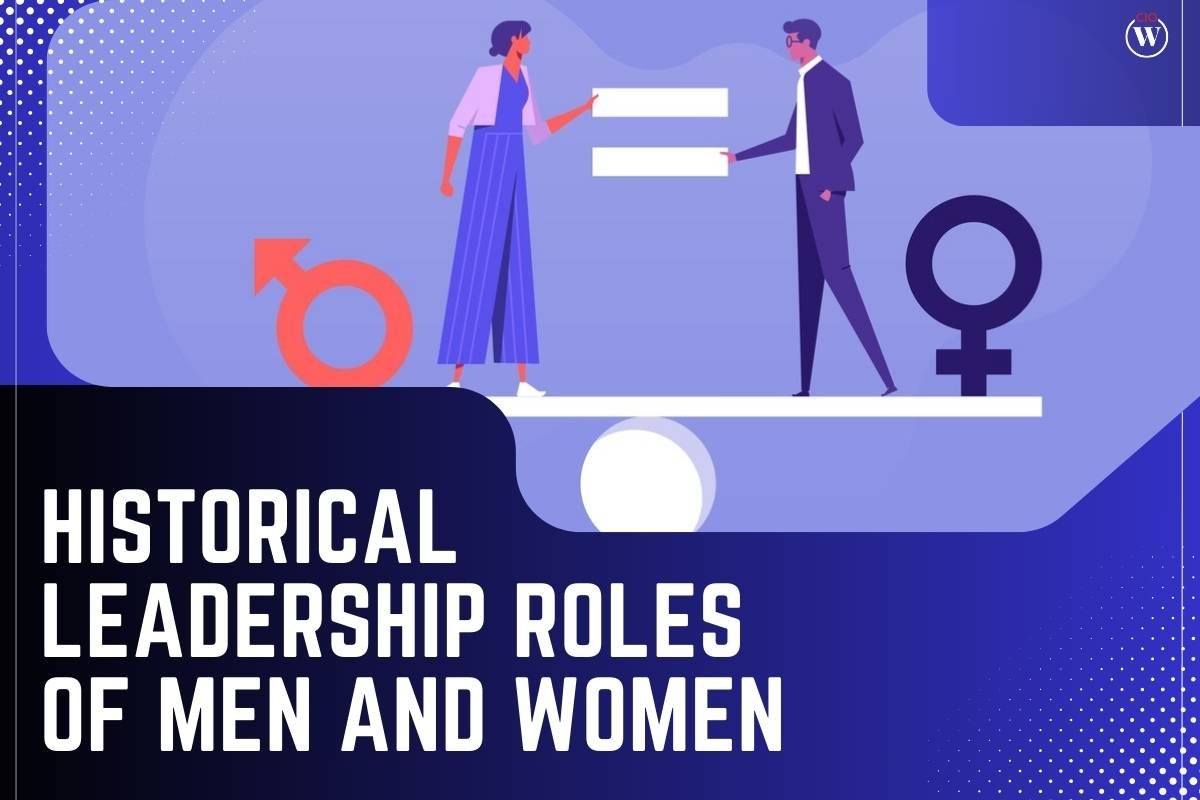Leadership is a concept that has been discussed and put into practice for centuries. Only in the last 80 years, however, has leadership become the subject of significant research and debate. Knowing the factors that affect good leadership is crucial. While trying to maximize a leader’s efficiency, it’s important to consider all the factors that might affect their performance, and gender is only one of them.
The professional, political, cultural, and personal realities of the twenty-first century demand serious and comprehensive analysis and debate on the issue of gender and leadership. It is important for both sexes to hold positions of leadership. Each leader’s full potential and effectiveness require taking into account their gender.
Here are the Historical Leadership Roles of Men and Women;
To cooperate to accomplish objectives beyond the capabilities of individuals, to establish families and other social groupings to fulfill affiliative needs, and to endure challenges from the environment and hazardous animals or other groups of people, Historical Leadership has always been a feature of human experience. Old Bible, New Testament, Bhagavad Gita, and Quran all discuss leaders and leadership. Throughout the last several centuries, many essays and dialogues about leadership have been published.
Almost eighty years ago, social psychologist Kurt Lewin and his students started researching group dynamics and making distinctions between authoritarian, democratic, and laissez-faire leadership styles, marking the beginning of the modern scientific study of Historical Leadership. From antiquity until the 1970s, males dominated discussions about leaders and leadership, with little attention paid to women in leadership roles or the intersection of gender and leadership.

The previous half-worth centuries of social, cultural, and political progress have made it abundantly evident that men and women can be good — and ineffective — leaders.
It is vital to go beyond the biological sex of the person and broad generalizations about what makes a male leader successful vs a female leader successful in order to maximize the leadership potential of both men and women. Examining the potential for and nature of a gender gap in Historical Leadership is crucial. Personal identity, social perception, and behavioral responses all vary depending on a person’s gender, making gender a significant kind of diversity indicator. So, it is important to think about how gender affects leadership performance.
Gender is a complex concept that encompasses how people are expected to behave, what they can and can’t do, and how their lives are constrained or expanded depending on their perceived sex and/or gender. The psychological and social effects of a person’s biological sex identity (i.e., their level of masculinity or femininity) (i.e., whether an individual is male or female). Gender is often operationalized via participant self-report or by observation of typical male and female behaviors.
But, there is a lot more to gender than only the psychological and social effects of biological sex. There are several dimensions to the gender phenomenon. Gender schemas and preconceptions, gender role identity, and gender role behaviors, beliefs, and attitudes are all part of this larger picture.
The World Health Organization (WHO) defines sex as the physiological and behavioral differences between males and females. “Gender” refers to the socially defined gender roles, activities, and characteristics that society deems proper for men and women.
The core of one’s gender identity is formed via sex type, which is shaped by one’s upbringing, exposure to media, and other cultural factors. Four types of sex characterizations were recognized by Bem: sex-typed, cross-sex-typed, androgynous, and undifferentiated.
She classified people as sex-typed if they process and integrate information in line with their gender, as cross-sex-typed if they do the opposite, as androgynous if they process and integrate traits and information from both genders, and as undifferentiated if they don’t seem to process sex-typed information.
What causes some sorts of gender stereotypes to become so pervasive across cultures? Adolescents, in particular, are influenced by the Gender Schema Theory because it is simpler for them to integrate society’s stereotypically congruent rules if they already fit inside the culturally established categories of male and female. The Gender Schema Theory is a process hypothesis that reinforces harmful gender roles.
The development of a robust gender schema is encouraged by a heterosexual subschema that establishes appropriate social standards of masculinity and femininity. In many communities, the heterosexual subschema is considered to be the norm, and this subschema posits that men and women should be differentiated from one another.
When same-sex partnerships and gender fluidity become more widely accepted, gender stereotypes also shift. African-Americans, Asian-Americans, European-Americans, and Hispanic-Americans are the four ethnic groups that Lee and KashubeckWest examined using confirmatory factor analysis of young people in the United States.
The results showed that neither men nor women from any of the ethnic groups fit well into the binary masculine/feminine distinction postulated by Bem.
Gender encompasses not just biological characteristics but also how people behave and the responsibilities they are expected to play in society. Gender norms and expectations also vary throughout time and among cultures.
Traditionally, males have been given greater authority and influence since they are often seen as more socially superior to women. Gender and Historical Leadership is an important issue to examine in light of the recent shift in cultural norms around gender roles and the acceptance of individuals of different gender identities (independent of their biological sex). First, leadership is defined, and the FourCePITO conceptual framework for leadership is introduced, before any discussion of gender and leadership can begin.
1. Character
There’s nothing novel or ground-breaking about the premise that a leader’s character is crucially important. There are several instances of leaders in ancient literature (such as the Bible and Homer’s epic poems) whose unique attributes were heavily highlighted, such as Odysseus’ cunning, Solomon’s knowledge, and Hector’s heroism. The early works on the topic of Historical Leadership theory centered on the leader’s personality. Carlyle, the proponent of the “Great Man” idea of leadership, argued that great historical figures were marked by their superior character traits.

A leader’s efficacy might be affected by thinking about their personality. Important Historical Leadership traits, such as self-confidence, humility, trustworthiness, accountability, and integrity, do not discriminate based on gender. There are also distinctions in personality between men and women of the masculine and feminine sexes, such as the extent to which they are extraverted or introverted, how much they judge or feel, or how much they sense or perceive.
Differences in ethics, morals, and personal values are also inherent to each person and have nothing to do with a person’s sex or gender. But, while thinking about Historical Leadership styles and efficiency, it is vital to take into account gender as a key component of Character.
2. Implicit biases based on perceived gender
Gender stereotypes dictate how men and women “should” act based on preconceived notions about gender roles and traits. Confidence, assertiveness, independence, logic, and decisiveness are all agentic traits associated with males; communal traits associated with women include care for others, warmth, helpfulness, and nurturing.
While women and men are equally capable of leading, the gender stereotypes that portray women as nurturing and loving and males as competitive and authoritarian may have led some people to believe that women are less successful leaders. [29, 30] Any assumptions regarding the relative efficacy of male and female leaders based on sex or gender reflect a bias toward the Character dimension of Historical Leadership.
Intriguingly, unless the leadership function is “gendered,” both men and women do equally well in it (i.e., people expect the leader to be a man or a woman). Leaders of the typical sex and gender are more likely to be respected in such a setting. Since gender norms and the setting in which a leader operates have an impact on the latter’s efficiency, this result receives further attention in the “Context and Gender” section.

Traditional management effectiveness (e.g., time efficient, performance-oriented) is generally sex categorized as masculine, according to studies of Historical Leadership traits by gender (i.e., agentic as opposed to communal). This implies that males have traditionally been stereotyped as having the qualities essential to being a good manager or leader. In general, people anticipate males to have masculine attributes more than women do, and men have a higher expectation that successful managers would have these features.
Since agentic, rather than communal, inclinations are typically rewarded in Historical Leadership positions that go beyond management responsibilities, this might be especially difficult for women to overcome in the context of gender stereotypes. The Role Congruity Hypothesis posits that women’s leaders are unfairly judged for their actions because the agentic attributes essential to the job are at odds with the large communal qualities stereotypically associated with women.
If a leader’s job is defined more genetically (such as a military officer, political leader, or scientist), or if women fully satisfy their agentic qualifications, they are more likely to be negatively evaluated since their actions go against the societal norm of the feminine gender role.
Thus, women in Historical Leadership positions have contradictory expectations: as leaders, they should exhibit agentic skills (i.e., male attributes), yet as women, they should avoid coming off as “to macho.” So long as these traits are not misconstrued as unfit for a leader, women may be more positively received if they include more community behaviors (such as expression, friendliness, and participation) in their repertory.









